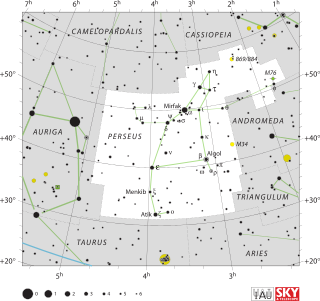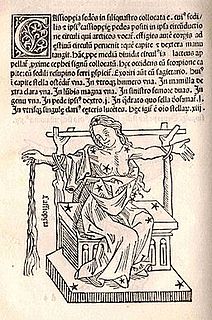
In Greek mythology, Andromeda is the daughter of the king of Aethiopia, Cepheus, and his wife, Cassiopeia. When Cassiopeia boasts that she is more beautiful than the Nereids, Poseidon sends the sea monster Cetus to ravage the coast of Aethiopia as divine punishment. Andromeda is chained to a rock as a sacrifice to sate the monster, but is saved from death by Perseus, who marries her and takes her to Greece to reign as his queen.

A Flamsteed designation is a combination of a number and constellation name that uniquely identifies most naked eye stars in the modern constellations visible from southern England. They are named for John Flamsteed who first used them while compiling his Historia Coelestis Britannica.

In Ancient Greek kētŏs, Latinized as cetus, is any huge sea creature or sea monster. According to the mythology, Perseus slew Cetus to save Andromeda from being sacrificed to it. In a different story, Heracles slew Cetus to save Hesione. The term cetacean derives from cetus. In Greek art, ceti were depicted as serpentine fish. The name of the mythological figure Ceto is derived from kētos. The name of the constellation Cetus also derives from this word.

Andromeda is one of the 48 constellations listed by the 2nd-century Greco-Roman astronomer Ptolemy, and one of the 88 modern constellations. Located north of the celestial equator, it is named for Andromeda, daughter of Cassiopeia, in the Greek myth, who was chained to a rock to be eaten by the sea monster Cetus. Andromeda is most prominent during autumn evenings in the Northern Hemisphere, along with several other constellations named for characters in the Perseus myth. Because of its northern declination, Andromeda is visible only north of 40° south latitude; for observers farther south, it lies below the horizon. It is one of the largest constellations, with an area of 722 square degrees. This is over 1,400 times the size of the full moon, 55% of the size of the largest constellation, Hydra, and over 10 times the size of the smallest constellation, Crux.

Cassiopeia is a constellation in the northern sky, named after the vain queen Cassiopeia in Greek mythology, who boasted about her unrivaled beauty. Cassiopeia was one of the 48 constellations listed by the 2nd-century Greek astronomer Ptolemy, and it remains one of the 88 modern constellations today. It is easily recognizable due to its distinctive 'W' shape, formed by five bright stars.

Perseus is a constellation in the northern sky, being named after the Greek mythological hero Perseus. It is one of the 48 ancient constellations listed by the 2nd-century astronomer Ptolemy, and among the 88 modern constellations defined by the International Astronomical Union (IAU). It is located near several other constellations named after ancient Greek legends surrounding Perseus, including Andromeda to the west and Cassiopeia to the north. Perseus is also bordered by Aries and Taurus to the south, Auriga to the east, Camelopardalis to the north, and Triangulum to the west. Some star atlases during the early 19th century also depicted Perseus holding the disembodied head of Medusa, whose asterism was named together as Perseus et Caput Medusae; however, this never came into popular usage.

In Greek mythology, Perseus is the legendary founder of Mycenae and of the Perseid dynasty. He was, alongside Cadmus and Bellerophon, the greatest Greek hero and slayer of monsters before the days of Heracles. He beheaded the Gorgon Medusa for Polydectes and saved Andromeda from the sea monster Cetus. He was the son of Zeus and the mortal Danaë, as well as the half-brother and great-grandfather of Heracles.

Clash of the Titans is a 1981 fantasy adventure film directed by Desmond Davis and written by Beverley Cross which is loosely based on the Greek myth of Perseus. It stars Harry Hamlin, Judi Bowker, Burgess Meredith, Maggie Smith and Laurence Olivier. The film features the final work of stop-motion visual effects artist Ray Harryhausen. It was released on June 12, 1981 and grossed $41 million at the North American box office, which made it the 11th-highest-grossing film of the year. A novelization of the film by Alan Dean Foster was published in 1981.
Chinese star names are named according to ancient Chinese astronomy and astrology. The sky is divided into star mansions and asterisms. The system of 283 asterisms under Three Enclosures and Twenty-eight Mansions was established by Chen Zhuo of the Three Kingdoms period, who synthesized ancient constellations and the asterisms created by early astronomers Shi Shen, Gan De and Wuxian. Since the Han and Jin Dynasties, stars have been given reference numbers within their asterisms in a system similar to the Bayer or Flamsteed designations, so that individual stars can be identified. For example, Deneb is referred to as 天津四.

In Greek mythology, Cepheus is the name of two rulers of Aethiopia, grandfather and grandson.

The Double Cluster consists of the open clusters NGC 869 and NGC 884, which are close together in the constellation Perseus. Both visible with the naked eye, NGC 869 and NGC 884 lie at a distance of 7,500 light years.

Andromeda is a lost tragedy written by Euripides, based on the myth of Andromeda and first produced in 412 BC, in a trilogy that also included Euripides' Helen. Andromeda may have been the first depiction on stage of a young man falling in love with a woman. The play has been lost; however, a number of fragments are extant. In addition, a number of ancient sources refer to the play, including several references in plays by Aristophanes.

Ceto is a primordial sea goddess in Greek mythology, the daughter of Pontus and his mother, Gaia. As a mythological figure, she is considered to be one of the most ancient deities, and bore a host of monstrous children fathered by Phorcys, another child of the Titans. The small solar system body 65489 Ceto was named after her, and its satellite after Phorcys.

Andromeda Chained to the Rocks (1630) is a 34 x 25 oil on panel painting by the Dutch Golden Age painter Rembrandt. It is now in the Mauritshuis, The Hague, Netherlands. Andromeda represents Rembrandt's first full length mythological female nude history painting and is taken from a story in Ovid's Metamorphoses.

Clash of the Titans is a 2010 action fantasy film and remake of the 1981 film of the same name produced by MGM. The story is very loosely based on the Greek myth of Perseus. An Australian-American production directed by Louis Leterrier from a screenplay by Travis Beacham, Phil Hay, and Matt Manfredi, starring Sam Worthington, Gemma Arterton, Mads Mikkelsen, Alexa Davalos, Ralph Fiennes, and Liam Neeson, the film was originally set for standard release on March 26, 2010. However, it was later announced that the film would be converted to 3D and was released on April 2, 2010.

Constellation families are collections of constellations sharing some defining characteristic, such as proximity on the celestial sphere, common historical origin, or common mythological theme. In the Western tradition, most of the northern constellations stem from Ptolemy's list in the Almagest, and most of the far southern constellations were introduced by sailors and astronomers who traveled to the south in the 16th to 18th centuries. Separate traditions arose in India and China.

In Greek mythology, Phineus was a son of Belus by Anchinoe and thus brother to Aegyptus, Danaus and Cepheus.

Urania's Mirror; or, a view of the Heavens is a set of 32 astronomical star chart cards, first published in November 1824. They are illustrations based on Alexander Jamieson's A Celestial Atlas, but the addition of holes punched in them allow them to be held up to a light to see a depiction of the constellation's stars. They were engraved by Sidney Hall, and were said to be designed by "a lady", but have since been identified as the work of the Reverend Richard Rouse Bloxam, an assistant master at Rugby School.

Perseus and Andromeda is an oil painting by Lord Frederic Leighton. Completed in 1891, the year it was displayed at the Royal Academy of Arts, it depicts the Greek mythological story of Andromeda. In contrast to the basis of a classical tale, Leighton used a Gothic style for the artwork. The painting is in the collection of National Museums Liverpool at the Walker Art Gallery.

Cassiopeia or Cassiepeia (Κασσιέπεια), a figure in Greek mythology, was Queen of Aethiopia and wife of King Cepheus. She was arrogant and vain, characteristics that led to her downfall. Her name in Greek is Κασσιόπη, Kassiope; other variants are Κασσιόπεια, Kassiopeia and Κασσιέπεια, Kassiepeia.


















